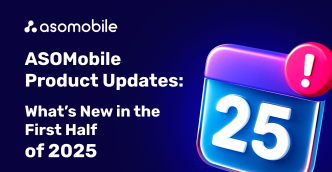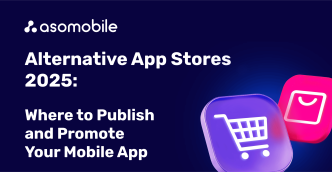Reinstalling Apps: Why You Should Pay Attention to Re-Downloads
Reinstalling Apps rates and re-downloads, what’s all the fuss about? In this article, we are going to break down this concept and share tips that can help you re-engage with former users!
What Is a Re-download and Why Does It Matter?
Are you paying attention to re-downloads and reinstalls? In this article, we are going to break down the concept of reinstalls and show you how you can boost your re-download rate by mastering App Store Optimization (ASO). Let’s get started!
At the end of the article, you can find a 40% discount coupon for the first month of using ASOMobile - a tool for creating ASO and researching competitors in the mobile app market.
What Is an App Reinstallation/Re Download?
If a user downloads an app, deletes it, and then downloads the same app again this is known as a reinstall or a re-download. Re-downloads are incredibly common and makeup 42% of all app downloads — amazingly, 98% of users have reinstalled an app at least once!
Tune recently unveiled their study on the phenomenon of reinstalling apps and came up with some interesting statistics:
- Re-downloads can total 75% of all downloads in certain niches.
- Search is the main driving force behind 65% of all reinstalls.
- Games are 55% more likely to be redownloaded than other programs.
- Major companies own 70% of the most redownloaded apps on the App Store.
Reinstalls are an important metric to track because they can give app creators unique insights into their apps. By tracking reinstalls, app developers can understand the seasonality of their program, spot problems that may cause a user to reinstall the same app multiple times, and find out the average length of time between when a user decides to remove an app and when they decide to re-engage with the software.
Why Do Users Reinstall Apps?
Now we have established just how pervasive the process of reinstalling apps is, let’s find out exactly why it occurs! Check out some of the most common reasons reinstalls occur:
- Almost 20% of users decided to delete and reinstall an app because it crashed or froze and they were hoping a reinstall would cure the issue.
- 13% of users required specific information, so they downloaded the app, retrieved the information, and then deleted the app. They then realized they needed additional information and reinstalled the program.
- 6% accidentally removed an app and promptly reinstalled it and had to reinstall it.
- 1% of users said they frequently deleted and reinstalled apps because the app was required to take advantage of particular sales and promotional deals.
Games are the most deleted and reinstalled category of apps. The high reinstall rate can be explained by the reason people generally download games — entertainment. It is common for a user to download a game, play it for a couple of days or weeks, become bored, and delete the app. Then a few weeks go by and the user feels a sudden urge to play the game again so they quickly redownload it.
Non-game apps typically serve a specific purpose and once the user fulfills this purpose they usually delete the app and only reinstall it once that they need to fulfill that specific purpose again. For example, someone may be traveling to a foreign country and want to learn a few basic phrases in their destination’s native language, so they download an app. Once they return home from their trip, they decide to delete the app. Then a few months later, when they start planning their next trip, they opt to learn another foreign language and happily reinstall the app. This concept of using apps for periods of time until a goal is met or information is acquired is known as seasonality and is a major driving force behind re-downloads and reinstalls.
How to Track Mobile Apps and Games Reinstalls?
If you want to ensure maximum usage of your app, you need to be tracking reinstalls and re-downloads because users can be enticed to come back and re-engage with your app if you use optimal retention and engagement strategies (we will explain these in the next section). Also, by studying reinstall rates, you can start to get a clear picture of the app’s lifecycle, but how exactly do you track reinstalls from the App Store and Google Play?
Via Apple’s App Store Connect, it is possible to view first-time downloads, re-downloads, the total number of downloads on the App Store. The ability to view re-downloads is a new feature that was added in October 2021. However, currently on the Google Play Store reinstall apps are not shown. The Google Play Console can show the number of installs by a particular user or the number of downloads by unique users.
There are 3rd party programs such as Adjust that can track re-downloads on both Google Play and the App Store. Adjust leverages the use of push notifications to monitor first-time downloads and reinstalls. Adjust allows you to see all reinstall data via their dashboard and even has the ability to send you real-time notifications whenever a user re-downloads an app.
How to Improve Reinstall Rate with ASO?
With a well-executed and multi-varied ASO strategy, you can successfully re-engage with past users and inspire them to reinstall your app. If you look at users’ willingness to give apps another chance (98% of users have previously reinstalled an app), you should not ignore the power of ASO in increasing your total number of users. Moreover, competent optimization will work well for both new and lost users.
Check out some simple but effective ASO tips!
- Optimize Your App’s Description
In the Apple App Store and Google Play, there is a designated field where app owners can describe their program and highlight its features. It is critical that you effectively sell your app by writing an engaging, simple-to-understand description that is filled with enough captivating information to convince a user to reinstall your app.
Don’t be afraid to add some statistics, emojis, and humor to your app’s description to make it more interesting. To boost your reinstall rate, you should also include multiple calls to action throughout your description which spurs the user to hit the download button!
In the description of the App Store and Google Play, there is a specific section titled “What’s New”. It is the ideal space to target former users who are thinking of re-downloading your app. Show them that you are making a conscious effort to address specific issues that caused users to delete your app.
For example, previous problems have been rectified and crashes are down X% and speed is up X%. Or if you realized that many users were deleting your game because they were becoming bored, explain how you have enhanced the gameplay by making new levels, adding new characters, and creating additional modes.
If you can create a “What’s New” section that is clear, engaging, and specifically addresses the pain points that former users were experiencing, the chances of them giving your app another go and re-installing it increases significantly. Remember, when writing the “What’s New” section to avoid technical language, keep it short and simple, and only talk about problems you are confident you have fixed!
- Revitalize the Visual Design of Your App Listing
Humans are visual creatures, so we love to see pictures, videos, bright colors, and interesting designs. If you want to convince lost users to reinstall your app, you need to create a connection with them and get them to experience emotions. This can be done by including strategically chosen screenshots of your app and including a video that highlights the best features or shows gameplay.
Candy Crush does a great job of including videos and captivating screenshots, see the example below:
If you are a former user who is thinking of reinstalling an app and you open the listing, would you download the app if it had no screenshots, no videos and the listing had zero colors? You could greatly enhance your reinstall rate by spending a few hours revamping your app listing by adding a catchy video and some captivating screenshots. Remember, the media you add to your listing should be bright, evoke emotions in your potential users, and display useful information!
- Don’t Forget About Apple Search Ads!
Are you looking for ways to convince a user to reinstall App Store apps? Then Apple Search Ads is your answer! With Apple Search Ads, you can specifically target users who have previously downloaded your app but have now removed it.
Apple Search Ads allows your app to appear first in the App Store search results based on specific keywords and is highlighted in blue. With Apple Search Ads, you can also match your campaign with particular users and demographics (such as former users) without having to worry about bidding on keywords.
Here are some tips when setting up an Apple Search Ads Campaign:
- Define your audience — If you only want to target former users, select returning users.
- Vary your bids — You need to spend more on high volume keywords and less on low volume ones.
- Increase your daily caps — You don’t want to run out of budget or have top keywords restricted and miss out on targeting former users who just need a little push.
- Create a keyword pool — You need to consistently be on the lookout for new keywords and remove poor-performing keywords from your list.
- Don’t neglect ASO — Apple Search Ads work best when combined with a sound ASO strategy.
Apple Search Ads are incredibly effective and Apple claims an impressive 50% conversion rate. If you create a campaign that specifically targets former users, you should be able to achieve a conversion rate as high as 70%, sending your download rate through the roof!
Conclusion
App reinstalls are a powerful metric that can help you troubleshoot your app, improve the user experience and also boost the lifetime value of a customer. Reinstalls can be tracked via Apple Store Connect or 3rd party software such as Adjust.
If you want to take your app to the next level you need to not only monitor your reinstall rate but boost it with sharp ASO strategies, including optimizing your app description, adding captivating media to your listing such as videos and screenshots, and finally, you need to run an extensive Apple Search Ads campaign specifically targeting former users.
We would love to hear your opinion! Please comment below on what you think about tracking reinstall rates and what ASO strategies you have used to boost reinstalls.
 Українська
Українська  Русский
Русский  Español
Español 






